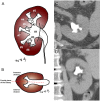Seoul National University Renal Stone Complexity Score for Predicting Stone-Free Rate after Percutaneous Nephrolithotomy
- PMID: 23824752
- PMCID: PMC3688830
- DOI: 10.1371/journal.pone.0065888
Seoul National University Renal Stone Complexity Score for Predicting Stone-Free Rate after Percutaneous Nephrolithotomy
Abstract
Objectives: Currently, no standardized method is available to predict success rate after percutaneous nephrolithotomy. We devised and validated the Seoul National University Renal Stone Complexity (S-ReSC) scoring system for predicting the stone-free rate after single-tract percutaneous nephrolithotomy (sPCNL).
Patients and methods: The data of 155 consecutive patients who underwent sPCNL were retrospectively analyzed. Preoperative computed tomography images were reviewed. The S-ReSC score was assigned from 1 to 9 based on the number of sites involved in the renal pelvis (#1), superior and inferior major calyceal groups (#2-3), and anterior and posterior minor calyceal groups of the superior (#4-5), middle (#6-7), and inferior calyx (#8-9). The inter- and intra-observer agreements were accessed using the weighted kappa (κ). The stone-free rate and complication rate were evaluated according to the S-ReSC score. The predictive accuracy of the S-ReSC score was assessed using the area under the receiver operating characteristic curve (AUC).
Results: The overall SFR was 72.3%. The mean S-ReSC score was 3.15±2.1. The weighted kappas for the inter- and intra-observer agreements were 0.832 and 0.982, respectively. The SFRs in low (1 and 2), medium (3 and 4), and high (5 or higher) S-ReSC scores were 96.0%, 69.0%, and 28.9%, respectively (p<0.001). The predictive accuracy was very high (AUC 0.860). After adjusting for other variables, the S-ReSC score was still a significant predictor of the SFR by multiple logistic regression. The complication rates were increased to low (18.7%), medium (28.6%), and high (34.2%) (p = 0.166).
Conclusions: The S-ReSC scoring system is easy to use and reproducible. This score accurately predicts the stone-free rate after sPCNL. Furthermore, this score represents the complexity of surgery.
Conflict of interest statement
Figures



References
-
- Ramello A, Vitale C, Marangella M (2000) Epidemiology of nephrolithiasis. J Nephrol 13 Suppl 3S45–50. - PubMed
-
- de la Rosette JJ, Laguna MP, Rassweiler JJ, Conort P (2008) Training in percutaneous nephrolithotomy–a critical review. Eur Urol 54: 994–1001. - PubMed
-
- Preminger GM, Assimos DG, Lingeman JE, Nakada SY, Pearle MS, et al. (2005) Chapter 1: AUA guideline on management of staghorn calculi: diagnosis and treatment recommendations. J Urol 173: 1991–2000. - PubMed
-
- Skolarikos A, Alivizatos G, de la Rosette JJ (2005) Percutaneous nephrolithotomy and its legacy. Eur Urol 47: 22–28. - PubMed
-
- de la Rosette J, Assimos D, Desai M, Gutierrez J, Lingeman J, et al. (2011) The Clinical Research Office of the Endourological Society Percutaneous Nephrolithotomy Global Study: indications, complications, and outcomes in 5803 patients. J Endourol 25: 11–17. - PubMed
Publication types
MeSH terms
LinkOut - more resources
Full Text Sources
Other Literature Sources

